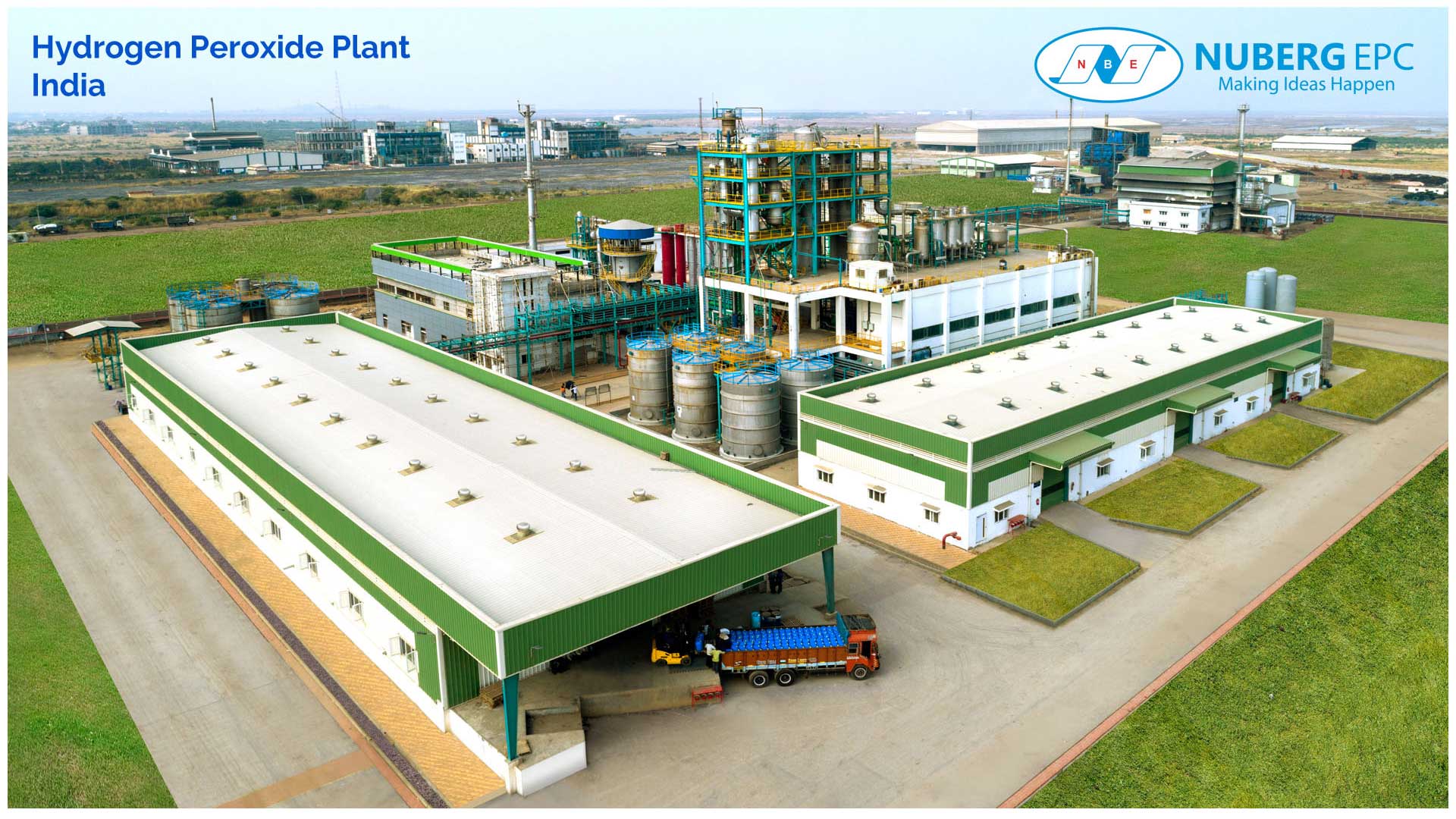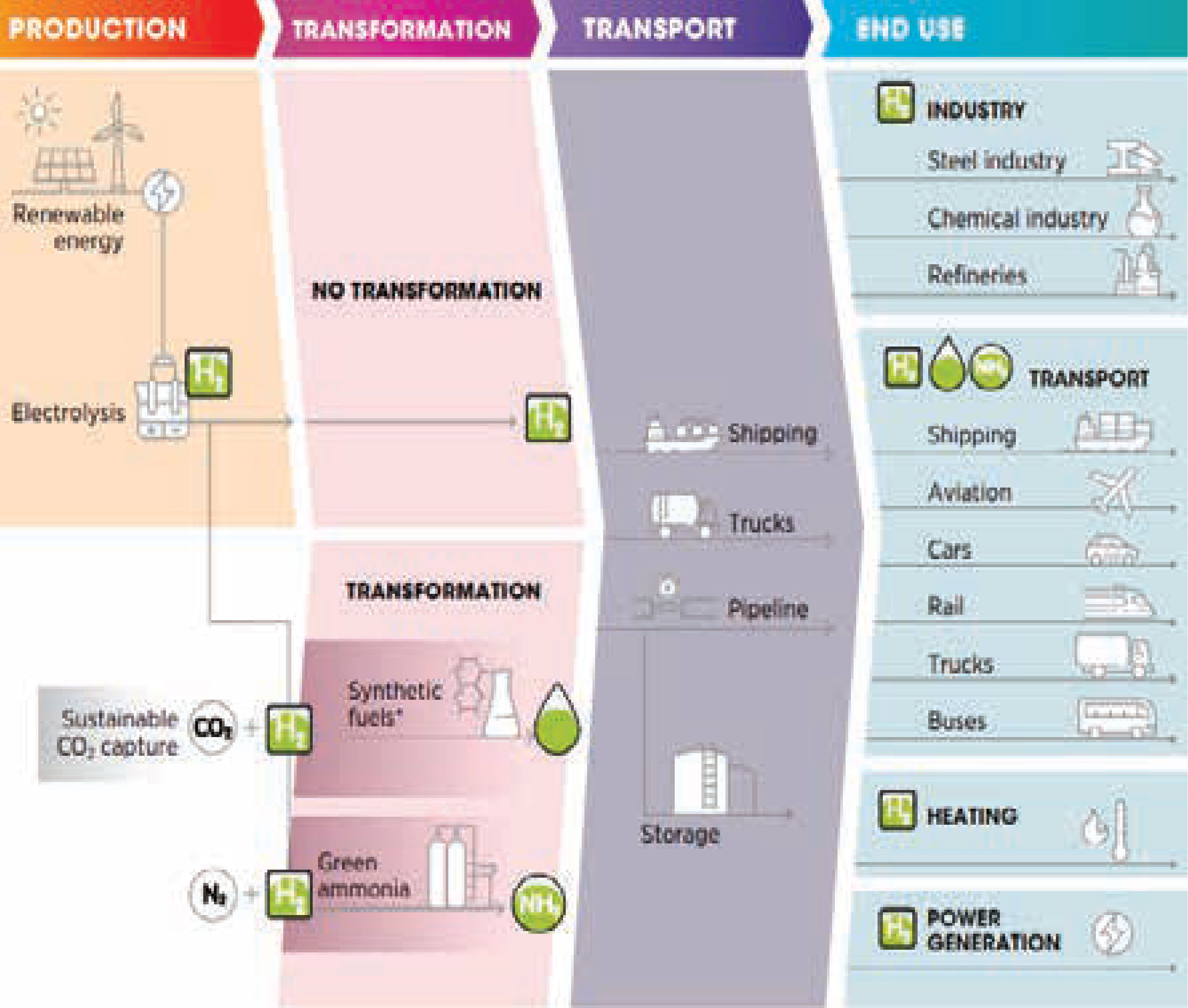
"The emerging Hydrogen economy is set to create ripple EPC impact, both upstream and downstream, in addition to the huge green electricity requirement. Industries producing currently waste Hydrogen will have a new source of income in addition to carbon credits."
AK Tyagi, CMD, Nuberg Engineering Limited.
EPC&I October 2021
According to The United
Nations Environment Programme
(that sets the global
environmental agenda within
the United Nations system), "in
response to heightening concerns
about the environmental impact of
energy use and worries about the security
of fossil-fuel supplies, Hydrogen,
as an energy carrier, can, in principle,
replace all forms of final energy in use
today and provide energy services to all
sectors of the economy. If hydrogen is
produced without emitting any carbon
dioxide or other climate-destabilising
greenhouse gases, it could form the
basis of a truly sustainable energy system
– the hydrogen economy."
More recently, Union Minister of
State (Independent Charge) Science
and Technology; Minister of State
(Independent Charge) Earth Sciences;
MoS PMO, Personnel, Public Grievances,
Pensions, Atomic Energy and
Space, Dr Jitendra Singh said that
India has the potential to become
Global Hub of Green Hydrogen by
2030 with global annual export potential
expected to be 10.4 million tonnes
to East Asia and EU, amounting to
nearly US$20-billion market. Aspirational
goal for India is 'Hydrogen 212'
– Green hydrogen generation cost of
less than $2.00/kg, Green hydrogen
storage + distribution + refuelling cost
of less than $1.00/kg and replacement
of incumbent end-use technology with
green hydrogen technology with ROI
of less than two years.
The minister informed that the
Government is already encouraging
adaptation of Hydrogen fuels and
technology for the mobility sector and
many industries like Steel, Cement,
and Glass Manufacturing Industries
have already started using Hydrogen
for heating requirements. Significantly,
in March 2021, Nuberg EPC was
commissioned to build India's first
commercial scale Hydrogen Purification
(fuel cell grade), Compression,
Storage and Dispensing Facility. The
1.5 TPD project is to be completed in
just 36 weeks from FOA, and involves
generation of ultra-pure hydrogen and
its storage at extremely high pressure.
Based on Absorption technology,
the plant will produce 99.997 per cent
pure Hydrogen. The storage facility
will contain record high pressure and
will be built using state-of-the-art
compression and storage system with automatic priority in dispensing the
gas. Hydrogen produced at the plant
will be used as a fuel for vehicles.

The success of the plant will enable
a revolution in India. Fuel cell vehicles
carry a hydrogen tank and produce
their own electricity, unlike other electric
vehicles, and, thus, cause zero pollution.
Countries like Norway, US,
Germany, Japan, South Korea, and
China are already running hydrogenfuelled
cars and buses. Already, there
are several hydrogen projects tendered
in India and many more are in the
pipeline.
Hydrogen is also being actively
evaluated and preferred as the fuel to
cater to India's enormous demand for
EPC in the next few years. Investment
of `8.00-lakh-crore is anticipated in
the Indian chemicals and petrochemicals
industry by 2025. 'Make in India'
across sectors, and India's increased
defence self-sufficiency needs, will also
create urgency for corresponding EPC.
CRISIL has already projected higher
growth of 15 per cent for mid-sized
EPC players this fiscal.
Globally, decarbonising energy and
other industries using hydrogen will
require investment of almost $15-trillion
between 2021 and 2050, according
to the Energy Transitions Commission
(ETC). Hydrogen use is forecast
to grow to 500-800 million tonnes a
year by mid-century, accounting for
15-20 per cent of total final energy
demand, from 115 million tonnes currently.
Producing this green hydrogen will
need zero-carbon electricity supply to
increase by 30,000 terawatt hours
(TWh) by 2050, on top of 90,000
TWh needed for decarbonisation generally.
This will require investment of
around $15-trillion, peaking in the late
2030s at around $800-billion per
annum, not just for hydrogen production
but for the electricity system to
support the massive increase in hydrogen
use, says ETC.
The emerging Hydrogen economy
is set to create ripple EPC impact,
both upstream and downstream, in
addition to the huge green electricity
requirement. Industries producing
currently waste Hydrogen will have a
new source of income in addition to
carbon credits.
Hydrogen production in symbiosis
with increasing number of renewable
power sources whose power capacity
is dependent of nature's unpredictability
promise a stabilised electric
power environment and will help
nations further fast-track renewable
power projects.
The consumer sectors of Hydrogen
economy will force a re-imagining of
some key products starting with automobiles
where heavy commercial vehicles
will have a viable zero emission
fuel (as electric HCV are seemingly not
viable in terms of cost and performance).
This will lead to fast tracking
of hydrogen distribution infrastructure
that will need to be created with all its
storage, pipeline, and pump components.
The availability of this hydrogen
refuelling infrastructure will bring
about a rethink in the electric vs
hydrogen cars equation resulting in
redesign for the new fuel source.
According to The International
Renewable Energy Agency (IRENA),
"many other uses of green hydrogen
include the additional conversion of
hydrogen to other energy carriers and
products, such as ammonia, methanol
and synthetic liquids. These uses can
increase the future demand for hydrogen
and can take advantage of possible
synergies to decrease costs in the green
hydrogen value chain. Green hydrogen
can, in fact, improve industrial competitiveness,
not only for the countries
that establish technology leadership in
its deployment but also by providing
an opportunity for existing industries
to have a role in a low-carbon future.
Countries with large renewable
resources could derive major economic
benefits by becoming net exporters of
green hydrogen in a global green
hydrogen economy."
Countries across the globe are
increasing their policy support for
the Hydrogen Economy. These
enabling policies cover several
aspects of the hydrogen economy –
from electricity generation for electrolysis
to infrastructure enablement,
financial models, and consuming
industry motivation.
The world is, thus, set to enter a
cleaner and less polluted era, and
this will create a massive ask of the
global EPC industry. At Nuberg EPC,
we are committed to providing world
class technologies and processes to
Indian and global industries in this
endeavour.
© This article was first published in EPC&I, October 2021.
Media Gallery
EPC&I - HYDROGEN ECONOMY – THE NEXT BIG WAVE?
Infrastructure Today - EPC Industry is Calibrating to a New Normal
Construction World - AK Tyagi, CMD, Nuberg Engg: EPC industry is calibrating to new normal
Construction Times - The core engineering talent with the company is our biggest strength
Chemical Engineering World - Healthy pipeline of projects
SiliconIndia - Nuberg EPC: Where Ideas Escalate to Expanses of Engineering Excellence
World Fertilizer - A World of Sulfur
International Cement Review - A new lime plant for Crescent
Process Worldwide - Making Ideas Happen, from Concept to Commissioning
World of Chemicals - EPC demand is rising in all dimensions of chemical industry
Financial Express - Indian firms can be world leaders in EPC
The Sunday Guardian - Engineering companies enthused by Make in India
Download PDF


